|
|
|
Sort Order |
|
|
|
Items / Page
|
|
|
|
|
|
|
| Srl | Item |
| 1 |
ID:
111414


|
|
|
|
|
| Publication |
2012.
|
| Summary/Abstract |
Quantifying wind potential is a pivotal initial step in developing and articulating a state's policies and strategies for offshore wind industry development. This is particularly important in the Great Lakes States where lessons from other offshore environments are not directly applicable. This paper presents the framework developed for conducting a preliminary assessment of offshore wind potential. Information on lake bathymetry and wind resources were combined in simulating alternative scenarios of technically feasible turbine construction depths and distance concerns by stakeholders. These yielded estimates of developable offshore wind areas and potential power generation. While concerns about the visibility of turbines from shore reduce the power that can be generated, engineering solutions that increase the depths at which turbines can be sited increase such potential power output. This paper discusses the costs associated with technical limitations on depth and the social costs related to public sentiments about distance from the shoreline, as well as the possible tradeoffs. The results point to a very large untapped energy resource in the Michigan's Great Lakes, large enough to prompt policy action from the state government.
|
|
|
|
|
|
|
|
|
|
|
|
|
|
|
|
| 2 |
ID:
103595
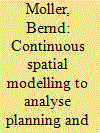

|
|
|
|
|
| Publication |
2011.
|
| Summary/Abstract |
Offshore wind resources appear abundant, but technological, economic and planning issues significantly reduce the theoretical potential. While massive investments are anticipated and planners and developers are scouting for viable locations and consider risk and impact, few studies simultaneously address potentials and costs together with the consequences of proposed planning in an analytical and continuous manner and for larger areas at once. Consequences may be investments short of efficiency and equity, and failed planning routines. A spatial resource economic model for the Danish offshore waters is presented, used to analyse area constraints, technological risks, priorities for development and opportunity costs of maintaining competing area uses. The SCREAM-offshore wind model (Spatially Continuous Resource Economic Analysis Model) uses raster-based geographical information systems (GIS) and considers numerous geographical factors, technology and cost data as well as planning information. Novel elements are weighted visibility analysis and geographically recorded shipping movements as variable constraints. A number of scenarios have been described, which include restrictions of using offshore areas, as well as alternative uses such as conservation and tourism. The results comprise maps, tables and cost-supply curves for further resource economic assessment and policy analysis. A discussion of parameter variations exposes uncertainties of technology development, environmental protection as well as competing area uses and illustrates how such models might assist in ameliorating public planning, while procuring decision bases for the political process. The method can be adapted to different research questions, and is largely applicable in other parts of the world.
|
|
|
|
|
|
|
|
|
|
|
|
|
|
|
|
| 3 |
ID:
115680


|
|
|
|
|
| Publication |
2012.
|
| Summary/Abstract |
Offshore wind energy (OWE) in the North Sea has the potential to meet large share of Europe's future electricity demand. To deploy offshore wind parks in a rational way, the overall OWE potential has to be realistically determined. This has to be done on an international, cross-border level and by taking into account the existing man-made and nature-related uses of the North Sea. As spatial conflicts will arise between existing uses and the new OWE uses, a Decision Support System (DSS) based on a Geographic Information System (GIS) was developed. Based on data of existing sea uses and calculation rules for spatial prioritisation analysis, the DSS helps in identifying areas that are (1) generally suitable for offshore wind power, (2) strictly excluded or (3) negotiable with respect to other existing sea uses. The combination of this conflict analysis together with cost assumptions for offshore wind farms and their expected electricity yield leads to identification of favourable areas for OWE deployment in the North Sea. This approach helps to reduce the conflict between offshore wind deployment and existing sea uses in the North Sea for future planning. The results can assist decision makers in developing transnational roadmaps for OWE.
|
|
|
|
|
|
|
|
|
|
|
|
|
|
|
|
| 4 |
ID:
177383
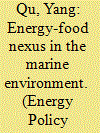

|
|
|
|
|
| Summary/Abstract |
The rapid development of offshore wind farms (OWFs) has stimulated debate about its overall socioeconomic impacts. Expanding the scale of OWFs increases the availability and affordability of electricity but could displace existing fishing activities and reduce food supply. To evaluate these impacts from a macroeconomic perspective, a computable general equilibrium (CGE) model is developed, using Scotland as a case study. A particular focus is placed on the disaggregated electricity and seafood sectors, their interconnectedness from an energy-food nexus perspective, and the distributional effects across household groups. This paper explores, from macroeconomic perspective, the trade-offs in the energy-food nexus between expanding OWFs and the seafood sectors, together with the impacts on food and energy security. The results suggest that, through economic linkages, increasing the number of OWFs would have a negative, but limited, effect on seafood production sectors. However, the falling cost of electricity from OWFs would have a positive impact on the economy overall and benefit lower income households, contributing to a reduction in fuel poverty. The model results raise the awareness of nexus linkages between OWFs and seafood production and are applicable to policies involving the development of other offshore renewables.
|
|
|
|
|
|
|
|
|
|
|
|
|
|
|
|
| 5 |
ID:
187602
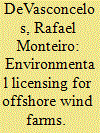

|
|
|
|
|
| Summary/Abstract |
Offshore wind energy is a key driver of the global energy transition towards climate change. The regulatory framework in environmental licensing for renewable energy sources is specific for each country, however there are basic elements that can be replicated for new markets. This article aims to propose guidelines and policy implications in environmental licensing for offshore wind projects for new markets based on the state of the art and lessons learned from three mature countries and one emerging market. The research involved three phases: literature review on sustainable development and environmental licensing procedures for offshore wind farms; research cases in the United Kingdom, Germany, Denmark, and Taiwan; and the structuring of guidelines and policy implications. As a result, eight guidelines and their policy implications are proposed, among them: (i) Establishment of a national offshore wind energy production target; (ii) Mapping of marine offshore wind zones; (iii) Adoption of a “one-stop-shop” procedure; (iv) Development of a guide for environmental licensing for offshore wind farms; and others. In conclusion, the establishment of a regulatory framework in environmental licensing for offshore wind projects, based on sustainable development principles and good practices of leading markets, guides public policies of new markets to have a greater probability of sustainable development.
|
|
|
|
|
|
|
|
|
|
|
|
|
|
|
|
| 6 |
ID:
133177


|
|
|
|
|
| Publication |
2014.
|
| Summary/Abstract |
The increasing demand for renewable energy drives the development of offshore wind energy (OWE) leading to competing claims with other human and nature related uses of the North Sea. This paper investigates possibilities to identify space for new OWE while minimising effects on other uses. An inventory is made of the major uses in the Central and Southern North Sea, including the expected development towards 2030. The spatial distribution of non-wind uses is determined as well as the possibilities for differentiation based on density, economic value or nature value and co-existence. These possibilities are translated into calculation rules quantifying the relative importance. These calculation rules have been incorporated in a Decision Support System (DSS) to analyse how the priority of OWE development could impact non-wind uses. In a low OWE priority scenario consequences for other use was found to be very limited, with fisheries and wildlife affected most. In a high OWE priority scenario a considerable amount of OWE may be developed with substantial claims on sand extraction and military use areas and a shift towards higher value categories for shipping and fisheries. Relocation and co-existence of uses are important means to reduce the impact of increased OWE development.
|
|
|
|
|
|
|
|
|
|
|
|
|
|
|
|
| 7 |
ID:
162920
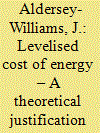

|
|
|
|
|
| Summary/Abstract |
Although widely accepted as a measure of the comparative lifetime costs of electricity generation alternatives, levelised cost of energy (LCOE) lacks a theoretical foundation in the academic literature and encompasses a number of areas where caution is important. Therefore, this paper seeks to provide a theoretical foundation by comparing the metric with alternative cost of energy metrics and by undertaking a brief literature review to describe its strengths and weaknesses. In comparison with other potential measures of unit cost of energy, LCOE is found to be the preferred choice, in large part because of its widespread adoption. The weaknesses of the LCOE are found to centre on discount rate, inflation effects and the sensitivity of results to uncertainty in future commodity costs. These weaknesses are explored in the context of comparing combined cycle gas fired generation and offshore wind in the UK, based on publicly available cost measures. It is found that with variability of future fuel gas prices, and a Monte Carlo approach to modelling LCOE, the range of LCOE for CCGT is much broader in comparison to the LCOE of offshore wind. It is urged that explicit account be taken of the areas of weakness in future use of LCOE.
|
|
|
|
|
|
|
|
|
|
|
|
|
|
|
|
| 8 |
ID:
126499


|
|
|
|
|
| Publication |
2013.
|
| Summary/Abstract |
The expansion of offshore wind energy as well as the increase in electricity trade between the North Sea countries leads to a growing need for additional transmission capacity. Due to the predominantly remote locations of offshore wind farms, the majority of future connections will be high-voltage direct current (HVDC) connections. In order to make the construction of offshore infrastructure more efficient, the North Sea states are currently discussing the development of a common offshore grid. Although this development still stands at the very beginning, we argue in this paper that some crucial elements should be standardized from the outset; the most important one being a common voltage level. Without such standardization, the development of a European offshore grid may be suboptimal, not cost-efficient and might even be prevented from coming into existence. We examine the technical and legal issues associated with introducing a common voltage level for the use of HVDC VSC technology, and discuss the optimal standard as well as the way in which this common standard can best be achieved.
|
|
|
|
|
|
|
|
|
|
|
|
|
|
|
|
| 9 |
ID:
104174
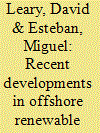

|
|
|
|
|
| Publication |
2011.
|
| Summary/Abstract |
This article examines the emergence of offshore renewable energy (i.e., offshore wind, ocean, and tidal energy) in the Asia-Pacific region with a particular focus on developments in China, South Korea, Australia, and New Zealand. It outlines plans for the development of offshore wind, tidal, and wave energy projects as well as emerging legal and policy measures supporting the growth of offshore renewable energy in the region. The article highlights that, although some progress has been made on laws and other measures to facilitate offshore renewable energy in the Asia-Pacific region, clear regulatory frameworks are still emerging in these jurisdictions.
|
|
|
|
|
|
|
|
|
|
|
|
|
|
|
|
| 10 |
ID:
166534
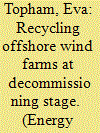

|
|
|
|
|
| Summary/Abstract |
Since Vindeby in 1991, more than 100 projects have been installed in Europe, and will need decommissioning one day. Despite the increasing number of projects reaching this phase, decommissioning is still an area that has received relatively little attention.
|
|
|
|
|
|
|
|
|
|
|
|
|
|
|
|
| 11 |
ID:
166443
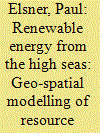

|
|
|
|
|
| Summary/Abstract |
Offshore wind energy projects are currently restricted to the exclusive economic zones of coastal States. Recent advances in technology are raising the prospect of utilising excellent wind resources on the high seas.
Using a global geo-spatial model we identify potential resource areas for this. In the shallow water case for bottom fixed foundations the largest locations are found on the Mascarene Plateau in the Indian Ocean and the Grand Banks in the North Atlantic. The deep water case for floating platforms identifies the largest regions on the Grand Banks/Flemish Cap and Rockall Bank/Hatton Ridge, both in the North Atlantic. The overall legal framework for wind energy projects on the high seas is the United Nations Convention in the Law of the Sea. Flag states will play a central regulatory role for high seas wind energy developments. There is the danger that flags of convenience might evolve and unduly undercut environmental and safety standards that are in place for projects on the territorial sea and EEZ. Such abuse of high seas freedom could compromise the UNCLOS principle of ‘due regard’. Marine spatial planning approaches and the establishment of cooperative mechanisms, led by the IMO, could safeguard against such potential misappropriation.
|
|
|
|
|
|
|
|
|
|
|
|
|
|
|
|
| 12 |
ID:
177342
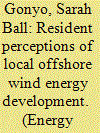

|
|
|
|
|
| Summary/Abstract |
Federal agencies anticipate local opposition where wind energy projects are proposed. When opposition manifests as social action in later stages of project development, it can complicate projects. Therefore, it is important to understand what mediates local opposition and oppositional action so potential concerns can be addressed earlier. Results indicate that Carolina coast residents are supportive of local offshore wind energy development, despite little to no awareness of such developments and uncertainty about potential impacts. Awareness and certainty of impacts are the largest drivers of support level, followed by perceived impacts. Residents generally believe local offshore wind energy will improve local economies but damage the environment; however, perceived impacts vary by factor importance. About twice as many Carolina coast residents intend social action related to local offshore wind energy compared to those who have engaged in related past actions. Holding a strong position and engagement in past actions are the largest drivers of intended action. For those in strong opposition, increased place attachment increases the odds of intending action, suggesting place-protective action. These findings enhance understanding about relevant values and perceptions from a broader range of stakeholders, which decision-makers can use to improve public engagement and participatory processes.
|
|
|
|
|
|
|
|
|
|
|
|
|
|
|
|
|
|
|
|
|